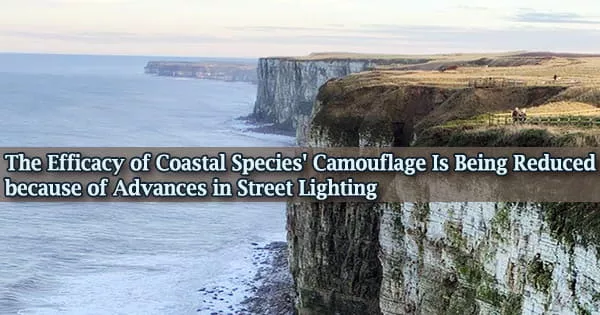According to a study, species that rely on darkness to forage and feed are losing their ability to disguise because of developments in lighting used to highlight the world’s cities and coastlines.
The widespread use of energy-efficient broad-spectrum lighting has the potential to disturb a variety of ecological processes that are governed by vision.
According to current research, these new lighting technologies can boost a predator’s capacity to differentiate prey species against a natural background by a factor of ten.
The extent of this effect varies based on the color of an organism, therefore particular color variations may be more vulnerable.
Researchers from the University of Plymouth and Plymouth Marine Laboratory collaborated on the study, which was published in the Journal of Applied Ecology (PML).
It’s one of the first studies to look into how artificial light at night (ALAN) can alter coastal animals’ camouflage capabilities.
Oak McMahon, who led the research while studying for an MSc in Applied Marine Science and is now a Ph.D. candidate at the University of Plymouth, said: “This study clearly indicates that new lighting technologies will increase the conspicuousness of prey species by reducing the efficacy of their camouflage.”
“Our findings revealed that species of Littorinid snails found commonly on our coastlines will remain camouflaged when illuminated by older style lighting. However, when illuminated by modern broad-spectrum lighting, they are clearly visible to predators and at far greater long-term risk as a result.”
As technologies develop, there has been a shift from narrow spectrum to lighting that enables us to live and travel in a safe, secure manner. However, estimates suggest that a quarter of the planet between the Arctic Circle and Antarctica is now being affected by night-time light pollution. Some predictions say that LED bulbs will account for 85% of the global street lighting market in around five years, and our study highlights that such advances will have repercussions for humans and animals alike now and in the future.
Dr. Thomas Davies
This is the most recent study by the University and PML to highlight the rising levels of ALAN and its effects on coastal habitats, which was funded by the Natural Environment Research Council.
The conspicuity of three distinct color morphs of Littorinid snails found widely along the world’s coastlines was determined using a well-established model in this study.
They examined how the animal looked when illuminated by different types of lighting to three known coastal predators. This comprised narrow-spectrum Low-Pressure Sodium (LPS) lighting from the twentieth century, three forms of current broad-spectrum lighting (High-Pressure Sodium (HPS), Light Emitting Diodes (LEDs), and Metal Halide (MH), as well as natural light from the sun and moon.
All snails were effectively disguised under LPS lights. Yellow snails, on the other hand, were much more visible than brown and olive snails when lighted by LEDs, MH, the sun, or the moon in the majority of circumstances.
Dr. Thomas Davies, Lecturer in Marine Conservation at the University of Plymouth and the study’s senior author, said: “As technologies develop, there has been a shift from narrow spectrum to lighting that enables us to live and travel in a safe, secure manner. However, estimates suggest that a quarter of the planet between the Arctic Circle and Antarctica is now being affected by night-time light pollution. Some predictions say that LED bulbs will account for 85% of the global street lighting market in around five years, and our study highlights that such advances will have repercussions for humans and animals alike now and in the future.”
Dr. Tim Smyth, PML Head of Science for Marine Biogeochemistry and Observations and co-author on the research, added: “The ability to light our environment around the clock has transformed the urban landscapes over the past century and has ushered in what some call the Urbanocene. The shift from the orange glow over cities, typical of my youth in the 1970s and 80s, has now shifted much more towards energy-efficient wide spectrum LEDs which even enables us humans to correctly perceive color.”
“This work shows that this advancement has additional ramifications for the natural world, which is having to adapt at an increasing rate to the artificial changes we are making to the environment. We need to learn to adapt our technologies to avoid the worst consequences of their adoption.”
What can be done to reduce the impact of artificial lighting on our coastlines
With estimations indicating that ALAN affects 23 percent of the world’s surface, primarily between the planet’s polar regions, and a rate of increase of 2.2 percent between 2012 and 2016, the need to solve the matter is urgent to say the least.
When evaluating its ecological implications, the researchers emphasize a variety of mitigation measures available to planners and environmental managers in the study.
These include lowering the quantity of light utilized, shielding lights to lessen their influence on the environment, using part-night lighting during peak demand periods, and modifying lighting spectra to reduce environmental impacts.
While it may seem natural to propose adopting narrow spectrum lighting to minimize these effects, the researchers point out that the effects of ALAN extend beyond those seen on camouflage, and that all regions of the visual spectrum will almost certainly have an ecological influence.





